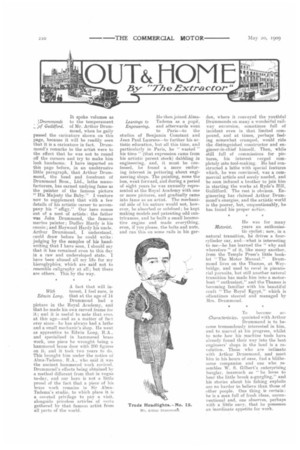It spoke volumes as
Page 12

If you've noticed an error in this article please click here to report it so we can fix it.
[Drummonds to the temperament of Guildford. of Mr. Arthur Drum mond, when he gaily passed the caricature shown on this page, because it will be readily seen that it is a caricature in fact. Drummond's remarks to the artist were to the effect that he was not to round off the corners and try to make him look handsome. 1 have imparted on this page before, in an unobtrusive little paragraph, that Arthur Drummond, the head and forefront of Drummond Bros., Ltd., lathe manufacturers, has earned undying fame as the painter of the famous picture " His Majesty the Baby." I venture now to supplement that with a few details of his artistic career to accompany his " effigy." Our hero comes out of a nest of artists: the father was John Drummond, the famous marine painter ; Dudley Hardy is his cousin ; and Heywood Hardy his uncle. Arthur Drummond, I understand; could draw before he could write: judging by the samples of his handwriting that I have seen, I should say that it has remained even to this day in a raw and undeveloped state. have been abused all my life for my hieroglyphics, which are said not to
resemble caligraphiy at ; but there are others. This by the way.
A feet that will in
With terest, 1 feel sure, is Edwin Long. that at the age of 14 Drummond had a picture in the Royal Academy, and that he made his own carved frame for it; and it is useful to note that, eye'. at this age—and as a matter of fact ever since– he has always had a lathe and a small mechanic's shop. He went as apprentice to Edwin Long, R.A., and specialised in hammered brass work, one piece he wrought being a hammered brass door with 200 figures on it, and it took two years to do. This brought him under the notice of Alma-nide/11a, B.A., who said it was the ancient hammered work revived, Drummond's effects being obtained by a method different from that in vogue to-day, and our hero is not a little proud of the fact that a piece of his brass work remains in Sir AlmaTadema's studio, to which place it is a coveted privilege to pay a visit, alongside priceless articles of reriu gathered by that famous artist from all parts of the world.
He then joined AlmaTadema, as a pupil, and afterwards went to Paris—to the studios of Benjamin Constant and Jean Paul Laurens—to further his artistic education, but all this time, and particularly in Paris, he " wasted " his time " (that expression came from his artistic parent stock) dabbling in engineering, and, it must be confessed, he found a more enduring interest in pottering about engineering shops. The painting, none the less, went forward, and during a period of eight years he was annually represented at the Royal Academy with one or more pictures, and gradually came into fame as an artist. The mechanical side of his nature would not, however, be absorbed or subdued; he kept making models and patenting odd contrivances. and he built a small locomotive engine and made everything, even, if ypu please, the bolts and nuts, and ran this on some rails in his gar
Leanings to Engineering. den, where it conveyed the youthful Drummonds on many a wonderful railway excursion, sometimes full of incident even in that limited compound, and at times, perhaps feeling somewhat cramped, would ride the distinguished constructor and engineer-in-chief himself. Then, while still full of commissions for pictures, his interest verged completely into tool-making. He had constructed a lathe with special features which, he was convinced, was a commercial article and sorely needed, and he soon induced a brother to join him in starting the works at Ryde's Hill, Guildford. The rest is obvious. Engineering has claimed Arthur Drummond's energies, and the artistic world is the poorer, but, unquestionably, he has found his proper metier.
He was for many
Motorist years an enthusias tic cyclist ; now, in a natural transition, he drives a fourcylinder car, and—what is interesting to me—he has learned the "why and wherefore " of it, like many another, from the Temple Press's little booklet " The Motor Manual." Drummond lives on the Thames, at Weybridge, and used to revel in piscatorial pursuits, but still another natural transition has made him into a motorboat " enthusiast," and the Thames is becoming familiar with his beautiful craft " The Royal Egypt," which is oftentimes steered and managed by Mrs. Drummond.
To become ac Chatacterislics, quainted with Arthur Drummond is to become tremendously interested in him, and to marvel at his progress, whilst to note how his machine tools have already found their wsy into the best engineers' shops in the land is a revelation. Those who are intimate with Arthur Drummond, and meet him in his hours of ease, find a blithesome companion and one who resembles W. S. Gilbert's enterprising harglar, inasmuch as " he loves to hear the little brook a-gurgling," and his stories about his fishing exploits are no harder to believe than those of other people. One thing is certain : he is a man full of fresh ideas, unconventional and, one observes, perhaps with a little envy, that he possesses an inordinate appetite for work.




















